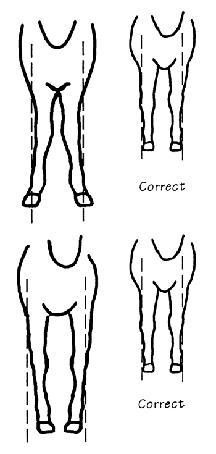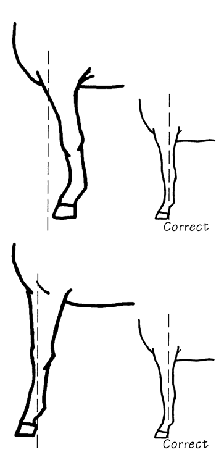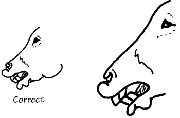
Weakness in Breeding Animals
All Donkeys have some weaknesses, but the degree and number of weaknesses and the cumulative effect on function and reproductive health is what needs to be kept in mind. Any animal with severe or multiple weaknesses should not be selected as breeding stock.
1. "Roman Nose" - Convex profile of the head. Coarseness of the head and neck.
2. Short, thick neck and low head carriage.
3. "Ewe Neck" - Thin, concave, weak neck.
4. "Roach Back" - Convex back.
Long, weak back; sway back (sagging).
5. Short, high or flat croup, hip too short (no depth of hip).
6. "Goose Rum" - Steep, sloping croup, narrow rump.

7. Insufficient bone in proportion to animal.
8. Too small to do the work that Miniature Donkeys are historically bred for.

9. "Cow Hocked" - The hocks of the back legs turn inward (toward) each other when viewed from behind.
10. "Bow Legs" - The hocks of the back legs turn outward (away) from each other when viewed from behind.
11. "Stands Close Behind" - The back legs are too close together. This is common in a narrow-bodied, flat-ribbed animal.

12. "Sickle Hocked" - The back legs stand in and under the animal
when viewed from the side.
13. "Camped Behind" - The back legs are set too far back behind the body when viewed from the side.

14. "Splay Footed" - Hooves of the front legs are turned outward and away from each other. This is common in narrow-chested animals.
15. "Pigeon Toed" - Hooves of the front legs are turned inward and toward each other.

16. "Standing Under In Front" - The front legs stand in and under the animal when viewed from the side.
17. "Camped In Front" - The front legs are set too far in front of the body when viewed from the side.
18. "Parrot Mouth" - Upper teeth extend out beyond lower teeth - Overshot Bite.

19. " Monkey Mouth" - Lower teeth extend out beyond upper teeth - Undershot Bite.

Up to 1/4" variation from an even bite (extreme limit) is accepted
for registration into the Miniature Donkey Registry.